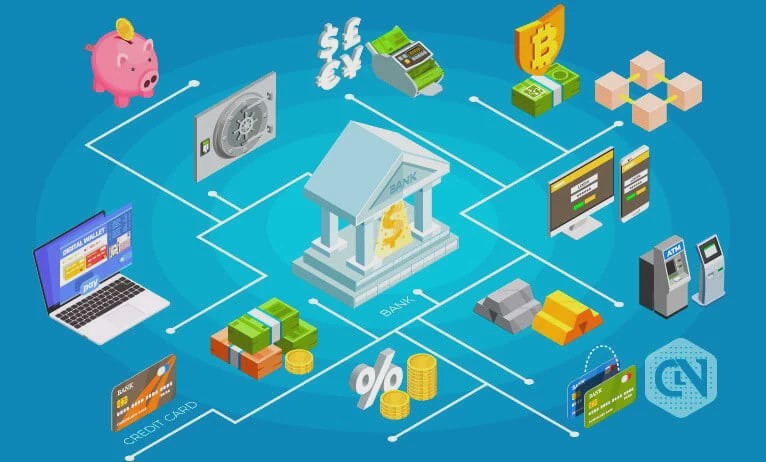
DeFi, or decentralized finance, is a blockchain-based financial system capable of stripping out traditional financial middlemen such as banks, brokerages, and exchanges.
It makes use of smart contracts to enable users to lend or borrow funds from others, bet on price fluctuations on a variety of assets using derivatives, insure against risks, and earn interest in savings-like accounts.
Because of it nature, a government-issued ID, social security number, or proof of address are not required. DeFi allows buyers, sellers, lenders, and borrowers to interact with one another or with a strictly software-based middleman rather than with a company or institution that facilitates a transaction.
To achieve the aim of decentralization, a variety of technologies and protocols are employed. A decentralized system, for example, might be made up of open-source technology, blockchain, and proprietary software. These financial products are made feasible by smart contracts, which automate agreement terms between buyers and sellers or lenders and borrowers. DeFi solutions, regardless of the technology or platform employed, are intended to eliminate middlemen between transacting parties.
Decentralized finance makes use of technology to disintermediate centralized models and enable the delivery of financial services to anybody, regardless of race, age, or cultural identity.
It lowers the barrier to admission.
Simultaneously, DeFi applications provide consumers more control over their money through personal wallets and trading platforms that cater to individual users rather than institutions.
How does it work?
DeFi provides services without the need of intermediaries by utilizing cryptocurrency and smart contracts. In today’s financial environment, financial institutions serve as transaction guarantors. Because your money flows through them, this gives these institutions enormous influence. Furthermore, billions of individuals throughout the world do not have access to a bank account.
A smart contract substitutes the financial institution in the transaction in DeFi. When a smart contract is live, no one can change it; it will always execute as planned. Smart contracts are also open to the public for inspection and auditing. As a result, defective contracts are frequently scrutinized by the community. This does imply that there is now a need to rely on more technical members of the community who can understand code. The open-source community helps keep developers in check, but this requirement will fade as smart contracts become simpler to comprehend and alternative methods of proving code’s integrity are created.
Main elements
There are certain DeFi “building blocks” that create a software stack, with every layer building upon another. These layers work together to create DeFi and its related applications that serve users in a variety of different ways. If one layer is off, so are the other layers.
The five layers that make up DeFi include:
1. Settlement: Foundational layer of the blockchain and its specific native asset. This layer provides security and a set of rules to follow.
2. Asset: Refers to all the tokens and digital assets that are native to the blockchain.
3. Protocol: Sets the protocols or guidelines for smart contracts.
4. Application: Brings the protocols to life with a user interface that is consumer-facing.
5. Aggregation: Consists of aggregators that connect the various dApps and protocols which make up the foundation for borrowing, lending on and other financial services.
Advantages and disadvantages
- Decentralization: It is difficult to censor or stamp out, but it does need some heavy-duty computer. Maintaining a database and records over a network of numerous computers slows things down and increases the cost of transactions.
- No intermediaries: There is no need for a third party to safeguard the assets. That means you don’t have to worry about a financial institution failing and taking your tokens with it — or about the government seizing and confiscating your tokens. On the other side, you and your passcode are the only things keeping your assets secure. If you lose (or someone steals) your passcode, your valuables are gone for forever.
- Available to anyone: Without typical financial credentials such as identification or a credit score, you may be able to obtain a loan or exchange virtual currency. That openness promises to bring financial services to sections of the world where they haven’t always been available, or where they are prohibitively expensive or prone to fraud or confiscation. However, the disadvantage is obvious: if nobody is keeping track of who is utilizing a service or where they are situated, the systems might be utilized by criminals or run counter to penalties. The regulatory crackdown is already in effect.
Applications
- Send money around the world quickly: Because blockchain technology is used, money may be moved in a safe and worldwide manner.
- Borrowing: Borrowing money from decentralized providers comes in two main varieties.
- Peer-to-peer, meaning a borrower will borrow directly from a specific lender.
- Pool-based where lenders provide funds (liquidity) to a pool that borrowers can borrow from.
- Lending: You can earn interest on your crypto by lending it and see your funds grow in real time.
- Access to global funds: When you utilize a decentralized lender, you have access to funds deposited from all over the world, not simply those held by your selected bank or institution. This increases the availability of loans and lowers interest rates.
- Stable coins: Volatility in cryptocurrencies is a concern for many financial products and ordinary spending. Stablecoins have been developed by the DeFi community to address this issue. Their value is fixed to another asset, generally a prominent currency such as the US dollar.
- Grow your portfolio: There are fund management products that will try to grow your portfolio based on a strategy of your choice. This is automatic, open to everyone, and doesn’t need a human manager taking a cut of your profits.
- Advanced trading: For traders who like a bit more control, there are more complicated alternatives. Limit orders, perpetual orders, leveraged trading, and more options are available. Decentralized trading gives you access to global liquidity, the market never closes, and you always have complete control over your assets. When you utilize a centralized exchange, you must deposit your assets prior to the deal and rely on them to protect them. Your funds are at danger while they are deposited because centralized exchanges are appealing targets for hackers.
- Exchange tokens: Decentralized exchanges let you trade different tokens whenever you want. You never give up control of your assets. This is like using a currency exchange when visiting a different country. But the DeFi version never closes. The markets are 24/7, 365 days a year and the technology guarantees there will always be someone to accept a trade.
- Insurance: The goal of decentralized insurance is to make insurance more affordable, faster to pay out, and more transparent. With more automation, coverage becomes very inexpensive and payouts become much faster. The information utilized to make a decision on your claim is totally transparent. Bugs and exploits are possible, like with any program. So, for the time being, many insurance products in the market are focused on safeguarding their customers from financial loss. However, programs are being launched to provide coverage for all life may throw at us. People who are typically priced out of standard insurance might benefit from decentralized insurance.
Final thoughts
DeFi is a vast financial ecosystem that aims to eliminate the intermediary and enable financial transactions between users. There is now a lot of buzz about DeFi and cryptocurrency. If you wish to participate, be sure you understand not just the benefits but also the hazards before you begin.


Thanks for sharing. I read many of your blog posts, cool, your blog is very good.
Can you be more specific about the content of your article? After reading it, I still have some doubts. Hope you can help me.
Your article helped me a lot, is there any more related content? Thanks!
This blog post is packed with great content!